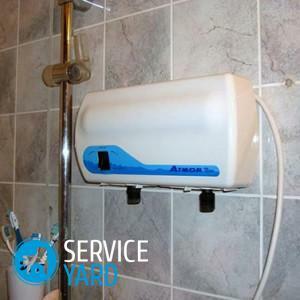
- Stand-alone installation
- Mounting
With the purchase of a water heater, you should also consider installing it. At the same time you can always contact the master, and you can save and install the water heater yourself. The principle of operation is simple, and if you deal with all the details in advance, you will save money, get a useful skill that you will need when servicing the heater. Let's look at the details.
to the contents ↑Self-installing
Of course, if you do not understand how to install, connect the device, or are afraid of damaging it - it's better not to risk and entrust all work to the master. In addition, if you live not on the first floor - if you connect incorrectly, a flood is possible, which will affect not only you, but also neighbors. But if you are not afraid of the difficulties, then you can begin the installation.
Advantages of self-installation:
- saving money;
- the ability to independently service the device during operation;
- knowledge of how to disassemble, dismantle the device.
Before any work needs to be properly prepared.
Preparation of
Before you purchase, determine the type of boiler, its dimensions, after - find the suitable place where the device will be located.
Recommendations:
- The selected location must be open for access not only at the time of installation, but also during the entire operation period of the device.
- If the device is attached to a wall, be aware that it must withstand weight - both the device itself and the water that will be in it.
- Before installation, be sure to check the condition of the pipes and wiring. If something needs to be replaced, it is better to do this before installing the boiler.
- After installation, it will be necessary to check the device.
Important! Never turn on the appliance for heating when the tank is empty. This can lead to both a breakdown of the device and a fire.
In order not to run headlong into the store during work, in advance, think over what materials, tools you will need, and prepare them.
Tools and materials:
- measuring tape or meter;
- perforator or drill;
- set of wrenches, adjustable wrench;
- nippers, pliers;
- set of screwdrivers;
- silicone sealant, FUM tape;
- tow;
- stopcocks;
- hoses;
- splitters.
After the preparation, you can finally learn how to install a boiler by yourself.
to the contents ↑Mounting
Heaters come in different types, and installation methods will naturally vary. Consider the basic steps for each type of device.
Flow heaters
These are small in weight and size boilers, the place for which can be selected without any difficulties. Often they are installed under the sink.
Important! It should be noted that despite the small size, these devices have a rather powerful heating system. This means that in order to avoid a fire, the state of the wiring should be treated with special attention.
Requirements:
- cable from 4 to 6 mm;
- counter is more than 40A;
- switch for 40A;The
- cable is PVA 3x6 or 3x8.
When all the nuances in relation to electricity are met, you can start the installation work. For flow types, this can be done by stationary and temporary options.
Temporary method
This option involves the use of a shower hose that is easy to close when not needed. At the same time, the cold water supply to the heating device is achieved by inserting the tee into the cold pipe, as well as installing a shut-off valve and connecting this system with a flexible hose.
Stationary
With this method, water is supplied in parallel with the central system. To install the boiler permanently:
- Use two splitters that are mounted on hot and cold pipes.
- Then put the shut-off valves and seal the joints.
- After the entire system is connected to the heater with hoses.
Important! Installation in this way involves shutting down the hot water supply.
Next, we will discuss the instructions for mounting a storage heater. 
Accumulation boiler
The storage heater heats and stores hot water in it. It allows you to maintain the user-defined water temperature.
This kind of boilers is very popular today, since it allows using hot water as needed and does not depend on its interruptions and outages. It is less expensive, compared to the previous model, and it is less demanding for wiring.
Important! The volume of storage boilers is different - from 50 to 500 liters. With a daily family of two people, a 50-liter device is enough, if more water is needed for a larger number of people, a more voluminous option should be chosen.
How to install a storage water heater:
- After delivery home - check the integrity of the device.
- Choose the installation location. The tank should always be accessible, but it does not interfere with you.
- Pencil or chalk make markings for the holes for the dowels.
- Drill holes and insert dowels and hooks into them.
- Check the walls. To do this, install the hooks on which you plan to install the water heater, and hang on them bags of sand or cement, by weight twice the weight of the boiler with water. If the mounts have passed the test - you can safely mount the device.
- We fix the boiler.
- To ensure that the water pressure is always good, do not install the boiler far from the place where it will collect water.
- We connect the input and output of the boiler from the previously connected connections.
- Install the pressure relief valve on the cold water inlet.
- Do not forget and seal the joints.
- Check the device. The test consists in the recruitment of water into the device and the inspection of all connections for leaks. If the device does not leak within an hour, it can be connected to the network and checked for heat.
Important! It is necessary to consider at what height to install the water heater. Usually from the point of attachment to the top is still a large gap, which inexperienced masters do not take into account and face the fact that the wall has to be drilled again.
Another type of water heater - gas.
Gas heater
Only certified masters can install a heater of this type. Independent work can lead to problems with the law and injuries. But if you have a developed project, documents and approvals to it, a gas pipe is installed and a counter is installed, then you can install a flowing gas water heater yourself.
Works:
- We find in the project the necessary place of installation, we do the marking for the dowels. Just like in the case of a storage boiler, we drill holes, twist the dowels and hooks and hang the device.
- Then it is necessary to take the corrugated pipe and install it so that all the carbon monoxide leaves the chimney. Connections must be tight.
- After - take a certified hose and connect the heater to the gas supply point.
- Then follows the test: it is necessary to open the gas supply and a strong soap solution to wipe all the joints well. If foam or bubbles begin to appear on the joints, this joint is tightened with a wrench. If there are bubbles, you will have to call the master. In addition, if you immediately turn to a professional, you will not only be sure of safety, but gas workers will not have questions or penalties for incorrect installation.
- If the gas is successful, water should be supplied. Here everything is simple: we take flexible hoses and conduct water in the same way as in any electric kind of heaters. After the wiring do not forget to seal the joints and check the device for leaks.
Important! The installation process of any boiler is labor-intensive enough, therefore, one should not work alone. This will not only facilitate the work process, but will also save time.
If you are thinking about how to install a water heater with your own hands - the simplest thing is to contact the service provider. But the cost of installation works often "bites", and if you need to remove the old boiler - you will be asked to pay extra and for its dismantling. Therefore, many people make the decision to save money and make the installation themselves. In addition, if you understand the nuances - it's not difficult. Detailed instructions for installing your heater model can always be found on the manufacturer's website.



